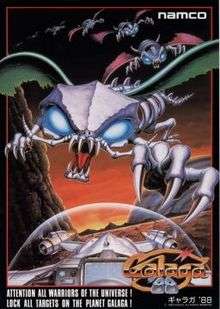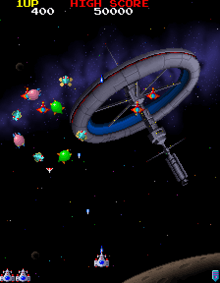Galaga '88
Galaga '88[lower-alpha 1] is a 1987 fixed shooter arcade game by Namco. It is the third sequel for Galaxian (following Galaga, and Gaplus). It features significantly improved graphics over the previous games in the series, including detailed backgrounds, larger enemies and greater ship details. The game runs on Namco System 1 hardware. First ported on the NEC PC Engine, it was later released on the North American TurboGrafx-16 under the name Galaga '90 and the Game Gear in Japan under the name of Galaga '91[lower-alpha 2], and in Europe under the name of Galaga 2.
| Galaga '88 | |
|---|---|
 Promotional sales flyer | |
| Developer(s) | Namco |
| Publisher(s) |
|
| Composer(s) | Hiroyuki Kawada |
| Series | Galaxian |
| Platform(s) | Arcade, TurboGrafx-16, Game Gear, Sharp X68000, Mobile phone |
| Release | |
| Genre(s) | Fixed shooter |
| Mode(s) | Single-player, multiplayer (alternating turns) |
| Cabinet | Upright |
| Arcade system | Namco System 1 |
Galaga '88 was not as commercially-successful as its predecessors, but was greatly praised for its gameplay, graphics, and music. Reviewers complemented its new enhancements that changed and innovated the core gameplay, and for standing out among other games at the time. It has been ported to many home consoles, such as the TurboGrafx-16 and Game Gear, and is included in many Namco compilations. It was followed by Galaxian3: Project Dragoon in 1990.
Gameplay

In Galaga '88, the player assumes control of a starship named the Blast Fighter[1] in its mission to destroy the Galaga forces and their home planet. Gameplay is similar to the original Galaxian and Galaga; the player fires projectiles at the Galaga aliens in each level, which will fly into formation from the top and sides of the screen. Aliens will dive towards the player while firing their own projectiles; colliding with either projectiles or aliens will result in a life being lost.
Atop the enemy formation are four large aliens known as the "Boss Galaga", which take two shots to destroy. These aliens can use a tractor beam to capture the player's ship, returning with it to the top of the formation and costing the player a life. Should additional lives remain, the player has an opportunity to shoot down the Boss Galaga holding the captured ship. Shooting it down as it dives towards the player will result in the captured ship being rescued, and it will join the player's ship, transforming it into a "dual-fighter" with additional firepower and a larger hitbox. However, destroying a Boss Galaga with a captured ship while it is in formation will instead cause the fighter to turn against the player and act as an alien.
Galaga '88 poses many new mechanics and ideas that separate itself from previous entries. Alongside the dual fighter, the player can also acquire a triple fighter with much more powerful shots by having a Boss Galaga capture a dual fighter and shooting it down. The game is divided up into five words, containing three to four levels each. At the end of each world, the player is treated to a bonus stage, indicated by the text "That's Galactic Dancin"; enemies will fly in a pre-set formation without firing at the player. Some levels contain obstacles such as asteroids and mines; shooting them down awards the player with a warp capsule, which after collecting two will allow the player to travel to another world. Worlds also feature a vertical-scrolling stage with a boss fight at the end. The game is built on a branching level system, determined by where the player collects the warp capsules and the worlds they travel to. After destroying the final boss, the player is treated to one of four endings, each based on their performance in the game.
Release
Galaga '88 was published by Namco in Japan in December 1987. It was released in April 1988 by Atari Games, being part of their licensing deal with Namco that gave them permission to distribute their more popular titles overseas.
Galaga '88 was ported to the NEC PC Engine/TurboGrafx 16, but was released outside Japan as Galaga '90. It was also ported to the Sega Game Gear as Galaga '91 in Japan and Galaga 2 in Europe. In 2005, the arcade version of Galaga '88 finally arrived on home systems as part of the Namco Museum: 50th Anniversary compilation for the PlayStation 2, Xbox, Nintendo GameCube and PC platforms. The arcade version is also on Namco Museum Virtual Arcade for Xbox 360 and Namco Museum for Nintendo Switch.
The PC Engine version of Galaga '88 was released on the Wii's Virtual Console service in Japan on March 27, 2007 and later as the game's arcade version on June 23, 2009. In North America, Galaga '90 was released via Virtual Console on August 6, 2007, and in Europe on August 10, 2007. The game was also re-released as part of the Pac-Man's Arcade Party arcade machine in 2010.
Galaga '88, along with Galaxian, the original Galaga, and Gaplus, was "redesigned and modernized"[2] for an iOS application compilation called the Galaga 30th Anniversary Collection, released in commemoration of the event by Namco Bandai. The collection app comes with Galaxian as a free game, with the remaining three games available in-app for $3 each or the complete set for $8. The app also features "Galaga points", collected as the games are played and used to unlock various consumable power-ups and special arcade cabinet designs, including the original art for each game.[3]
Reception
| Reception | ||||||||||||
|---|---|---|---|---|---|---|---|---|---|---|---|---|
| ||||||||||||
| ||||||||||||
Computer + Video Games liked its cute visuals and new additions to the core Galaga gameplay,[9] while The Games Machine applauded its addictiveness, soundtrack and replay value. Your Sinclair labeled it "one of the most enjoyable machines on offer this month".[10] Advanced Computer Entertainment was more negative towards the game for being "nothing more than a prettified version of the original", although they praised its colorful, detailed visuals and soundtrack.[11] Gamest magazine awarded it the 28th "Annual Hit Game" award in 1998 based on reader vote, citing that its addictive nature, colorful visuals and catchy music made Galaga '88 stand out among other games at the time.[8]
In a 1998 retrospective review, Allgame was positive towards the game's graphics, branching level paths and overall improvements made over its predecessor.[4] They also found the TurboGrafx-16 conversion to be a "killer port" for keeping the spirit of the original, going on to call it the best shooter released for the system.[5] Reviewing the Wii Virtual Console digital re-release of the TurboGrafx port, Eurogamer found it to be a "pitch perfect dose of frenetic arcade blasting" for its triple fighter mechanic and branching stages, saying that it sets a good example for how to successfully remake a classic arcade game.[6]
References
- "UGSF Series Official Site" (in Japanese). Bandai Namco Entertainment. Archived from the original on 16 June 2019. Retrieved 6 April 2020.
- "Jesse David Hollington, "Namco releases Galaga 30th Anniversary Collection"". 2011-06-09.
- "Galaga 30th Anniversary Collection information from Apple iTunes". 2011-06-09.
- Alan Weiss, Brett (1998). "Galaga '88 - Review". Allgame. Archived from the original on 15 November 2014. Retrieved 20 October 2019.
- Alan Weiss, Brett (1998). "Galaga '90 - Review". Allgame. Archived from the original on 15 November 2014. Retrieved 20 October 2019.
- Whitehead, Dan (13 August 2007). "Virtual Console Roundup - Galaga 90". Eurogamer. p. 2. Archived from the original on 5 March 2016. Retrieved 20 October 2019.
- J'm DESTROY (December 1991). "Galaga '91" (in French) (22). Joystick. p. 131. Archived from the original on 12 March 2016. Retrieved 20 October 2019.
- GAMEST MOOK Vol.112 - The Best Game 2 Arcade Video Game History of 26 Years (Volume 5, Issue 4 ed.). Gamest. January 17, 1998. pp. 22–23. ISBN 9784881994290.
- "Galaga '88". Computer + Video Games. May 1988. p. 118. Archived from the original on 16 September 2019. Retrieved 22 October 2019.
- Brennan, Ciaran (June 1988). "Slots of Fun - Galaga 88". Your Sinclair. p. 75. Archived from the original on 16 September 2019. Retrieved 22 October 2019.
- Jenkins, Chris (March 1988). "Back To The Future - Sequels". Advanced Computer Entertainment. p. 26. Archived from the original on 16 September 2019. Retrieved 22 October 2019.